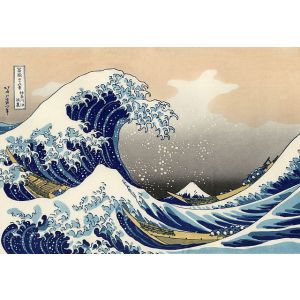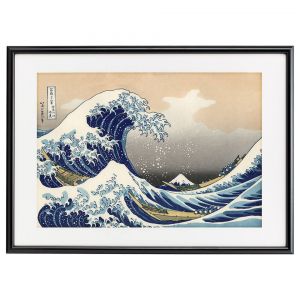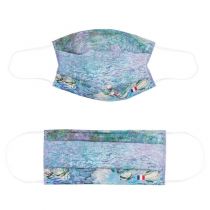Cart is empty
ΚΑΤΗΓΟΡΙΕΣ
- 1922-2022 100 Χρονια Μικρασιατικη Εκστρατεία
- Σωτήρης Σορογκας
- 1821-Greek Revolution
- Le Louvre
- Van Gogh Museum
- The Metropolitan Museum of New York
- Rijksmuseum
- Claude Monet
- Gustav Klimt
- Rodin-
- Vincent van Gogh
- Auguste Renoir
- Andy Warhol
- Marc Chagall
- Jan Vermeer
- Katsushika Hokusai
- Leonardo da Vinci
- Alfonse Mucha, Prague
- Museum Art IS
- Pablo Picasso
- Paul Cezanne
- Ναπολέων Βοναπάρτης
- mothers day
- Easter
- Αίγυπτος
- Frida Kalho
The Great Wave off Kanagawa (神奈川沖浪裏 Kanagawa-oki nami ura?, "Under a wave off Kanagawa"), also known as The Great Wave or simply The Wave, is a woodblock print by the Japanese ukiyo-e artist Hokusai. It was published sometime between 1830 and 1833[1] in the late Edo period as the first print in Hokusai's series Thirty-six Views of Mount Fuji. It is Hokusai's most famous work, and one of the most recognizable works of Japanese art in the world.
The image depicts an enormous wave threatening boats off the coast of the prefecture of Kanagawa. While sometimes assumed to be a tsunami, the wave is more likely to be a large rogue wave.[2] As in all the prints in the series, it depicts the area around Mount Fuji under particular conditions, and the mountain itself appears in the background.
Impressions of the print are in many Western collections, including the Metropolitan Museum of Art, the British Museum, the Art Institute of Chicago, the Los Angeles County Museum of Art, the National Gallery of Victoria in Melbourne,[3] and in Claude Monet's house in Giverny, France, among many other collections.
''The Great Wave' Katsushika Hokusai (1760-1849)
Museum Paris - Musée des Arts asiatiques–Guimet
Themes Asia, Prints
Art movements Asiatic art, 19th century
Artist Katsushika Hokusai (1760-1849)
Hokusai began painting when he was six years old and at twelve, his father sent him to work at a booksellers. At sixteen, he was apprenticed as an engraver and spent three years learning the trade. At the same time he began to produce his own illustrations. At eighteen he was accepted as an apprentice to Katsukawa Shunshō, one of the foremost ukiyo-e artists of the time.
In 1804 he became famous as an artist when, during a festival in Tokyo, he completed a 240m² painting[4] of a Buddhist monk named Daruma. In 1814, he published the first of fifteen volumes of sketches entitled Manga. His Thirty-six Views of Mount Fuji, from which the Great Wave comes, was produced from around c. 1830.[5]
Description[edit]
This print is a yoko-e, that is, a landscape format produced to the ōban size, about 25 cm high by 37 cm wide.[11] The composition comprises three main elements: the sea whipped up by a storm, three boats and a mountain. It includes the signature in the upper left-hand corner.
The mountain
Further information: Mount Fuji The mountain with a snowcapped peak is Mount Fuji, which in Japan is considered sacred and a symbol of national identity,[12] as well as a symbol of beauty.[13] Mount Fuji is an iconic figure in many Japanese representations of famous places (meisho-e), as is the case in Hokusai's series of Thirty-six Views of Mount Fuji, which opens with the present scene. The dark color around Mount Fuji seems to indicate that the scene occurs early in the morning, with the sun rising from behind the observer, illuminating the mountain's snowy peak. While cumulonimbus storm clouds seem to be hanging in the sky between the viewer and Mount Fuji, no rain is to be seen either in the foreground scene or on Mount Fuji, which itself appears completely cloudless.[2]
Boats
In the scene there are three oshiokuri-bune, fast boats that are used to transport live fish[14] from the Izu and Bōsō peninsulas to the markets of the bay of Edo. As the name of the piece indicates the boats are in Kanagawa prefecture, with Tokyo to the north, Mt Fuji to the northwest, the bay of Sagami to the south and the bay of Tokyo to the east. The boats oriented to the southeast, are returning to the capital. There are eight rowers per boat, clinging to their oars. There are two more passengers in the front of each boat, bringing the total number of human figures in the image to thirty. Using the boats as reference, one can approximate the size of the wave: the oshiokuri-bune were generally between 12 and 15 meters long, and noting that Hokusai reduced the vertical scale by 30%, the wave must be between 10 and 12 meters tall.[2]
Sea and waves
The sea dominates the composition as an extending wave about to break. In the moment captured in this image, the wave forms a circle around the center of the design, framing Mount Fuji in the background. Edmond de Goncourt described the wave in this way:
The drawing of the wave is a deification of the sea made by a painter who lived with the religious terror of the overwhelming ocean completely surrounding his country; He is impressed by the sudden fury of the ocean's leap toward the sky, by the deep blue of the inner side of the curve, by the splash of its claw-like crest as it sprays forth droplets
Signature
Hokusai's signature
The Great Wave off Kanagawa has two inscriptions. The first, within a rectangular cartouche in the top-left corner is the series title: "冨嶽三十六景/神奈川冲/浪裏" Fugaku Sanjūrokkei / Kanagawa oki / nami ura, which translates as "Thirty-six Views of Mount Fuji / Offshore from Kanagawa / Beneath the wave". The second inscription, to the left, is the artist's signature: 北斎改爲一筆 Hokusai aratame Iitsu hitsu, ("From the brush of Hokusai, changing his name to Iitsu")
Over his career, Hokusai used more than 30 different names, always beginning a new cycle of works by changing it, and letting his students use the previous name.In his work Thirty-Six Views of Mount Fuji he used four distinct signatures, changing it according to the phase of the work: Hokusai aratame Iitsu hitsu, zen Hokusai Iitsu hitsu, Hokusai Iitsu hitsu and zen saki no Hokusai Iitsu hitsu.















